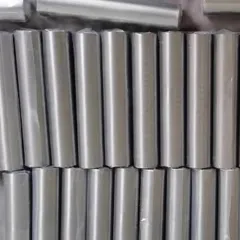- Home
- Products
- Elementary
- Boride Powder
- 3D Printing Powder
- Sulfide Powder
- Oxide Powder
- Carbide powder
- Nitride Powder
- Silicide Powder
- Hydride Powder
- Telluride Powder
- Selenide Powder
- Stearic Acid Series
- Phosphide Powder
- Nanoparticles
- Metal Alloy
- MAX Phase
- Lithium Battery Anode
- Surfactant
- Molecular sieves
- Concrete Admixtures
- Cladding of metals
- News
- Blog
- Contact
- About
Metal Alloy 99.99% Tantalum Ta Rod
Tantalum Ta Ro with 99.99% purity
Description of The Metal Alloy 99.99% Tunglum Ta Rod:
High melting point and good high-temperature strength: Tantalum rods have a high melting point and can maintain strength and stability in high-temperature environments. Therefore, tantalum rods are widely used to manufacture high-temperature furnaces and components.
Good electrical and thermal conductivity: Tantalum rods have excellent electrical and thermal conductivity and can transfer heat and current quickly. This makes tantalum rods widely used in the electronics and semiconductor industries to manufacture high-precision electronic devices and integrated circuits.
Good corrosion resistance: tantalum rods have good corrosion resistance in many chemical media, such as acids, alkalis, salts, etc. Therefore, tantalum rods are widely used to manufacture chemical reactors, pressure vessels, pipelines, and other equipment.
Good mechanical properties: Tantalum rods have mechanical properties such as high strength, high hardness, low plasticity, and low toughness, making them perform well in environments that withstand high loads and shocks. This makes tantalum rods have a good application prospect in the manufacture of high-strength parts and structural parts.
Easy processing and welding: Tantalum rods are easy to cut, drill, grind, and do other processing operations and can be readily welded. This makes tantalum rods more flexible and efficient in manufacturing complex-shaped parts and structures.
Non-toxic and biocompatible: Tantalum rods are considered a non-toxic metal material with good biocompatibility. Therefore, tantalum rods are widely used in the medical field to manufacture artificial joints, dental implants, and other medical supplies.

Applications of The Metal Alloy 99.99% Tunglum Ta Rod:
High-temperature furnaces and high-temperature components: Tantalum rods have a high melting point and can maintain strength and stability in high-temperature environments, so they are widely used to manufacture high-temperature furnaces and high-temperature components. It is used to manufacture electric arc furnaces, electron beam melting furnaces, plasma melting furnaces, and other high-precision and high-efficiency furnaces.
Electronics and semiconductor industry: Tantalum rods have excellent electrical and thermal conductivity and can quickly transfer heat and current, so they are widely used in electronics and semiconductors. It is used to manufacture high-precision electronic devices, integrated circuits, microelectronic components, etc.
Chemical reactors and pressure vessels: Tantalum rods have good corrosion resistance in many chemical media, so they are widely used to manufacture chemical reactors and pressure vessels. It is used to make reactors in chemical laboratories, pressure vessels in pharmaceutical factories, electrolytic cells in chlor-alkali factories, etc.
Aerospace field: Tantalum rod has high strength, high hardness, low plasticity, low toughness, and other mechanical properties, so it is widely used in the aerospace field. It is used to make parts for aircraft and rockets, blades for aer engines, etc.
Medical field: Tantalum rod is considered a non-toxic metal material with good biocompatibility, so it is widely used in medicine. It is used to manufacture artificial joints, dental implants, surgical instruments, and other medical supplies.
Production Method of The Metal Alloy 99.99% Tunglum Ta Rod:
Raw material preparation: First, tantalum metal raw materials must be prepared, usually using tantalum wire or sheet as raw materials. These raw materials must be inspected and processed to ensure their quality and dimensions meet the requirements.
Smelting and casting: tantalum raw materials are melted in a high-temperature melting furnace to form tantalum liquid. The tantalum liquid is poured into a mold and cast to create a tantalum rod.
Heat treatment: The cast tantalum rod is heat treated to eliminate internal stress and improve its mechanical properties.
Processing and cutting: After heat treatment, tantalum rods need to be processed and cut to obtain the desired size and shape. This usually includes operations such as turning, milling, drilling, etc.
Surface treatment: After processing, tantalum rods must be surface-treated to remove surface defects and oxide layers and improve their appearance and quality.
Quality testing: Finally, the tantalum rod must be tested to ensure its quality and performance meet the requirements. This includes dimensional measurement, physical property testing, chemical composition analysis, etc.
Packaging and transportation: After quality testing, tantalum rods can be packaged and transported to protect their safety and quality during transportation.
Payments & Transport:
Metal Alloy 99.99% Tantalum Ta Rod Properties | |
| Other Titles | Tantalum rod |
| N/A | |
| Compound Formula | Ta |
| Molecular Weight | N/A |
| Appearance | Rod and bar |
| Melting Point | N/A |
| Solubility In Water | N/A |
| Density | N/A |
| Purity | 99.99% |
| Size | Individualized |
| Boling Point | N/A |
| Specific Heat | N/A |
| Thermo Conductivity | N/A |
| Thermal Expansion | N/A |
| Young's Module | N/A |
| Exact Weight | N/A |
| Monoisotopic | N/A |
Metal Alloy 99.99% Tantalum Ta Rod Safety & Healthcare Information | |
| Safety Notice | N/A |
| Hazard Statements | N/A |
| Flashing Point | N/A |
| Hazard Codes | N/A |
| Risk Codes | N/A |
| Safety statements | N/A |
| RTECS # | N/A |
| Transport Information | N/A |
| WGK Germany | N/A |
Inquiry us
PREVIOUS Metal Alloy
Metal Alloy High Temperature Inconel718 Alloy Rod
NEXT Metal Alloy